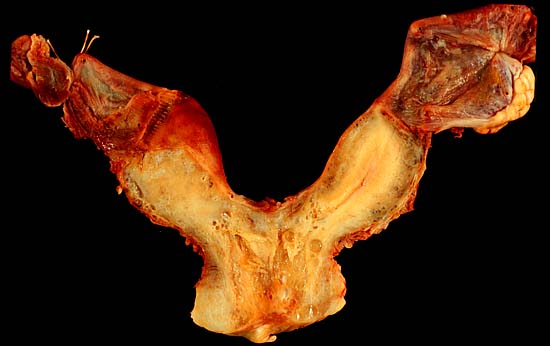Uterine malformation
| Uterine malformation | |
 | |
|---|---|
| A human bicornuate uterus | |
| ICD-10 | Q51 |
| ICD-9 | 752.2-752.3 |
Editor-In-Chief: C. Michael Gibson, M.S., M.D. [1]
A uterine malformation is the result of an abnormal development of the Mullerian duct(s) during embryogenesis. Symptoms range from amenorrhea, infertility and pain, to normal functioning depending on the nature of the defect. Uterine malformations affect about 1% of the female population.
Types
The American Fertility Society (now American Society of Reproductive Medicine) Classification distinguishes:
- Class I: Mullerian agenesis (absent uterus).
- Uterus is not present, vagina only rudimentary or absent. The condition is also called Mayer-Rokitansky-Kuster-Hauser syndrome. The patient with MRKH syndrome will have primary amenorrhea.
- Class II: Unicornuate uterus (a one-sided uterus).
- Only one side of the Mullerian duct forms. The uterus has a typical "banana shape" on imaging systems.
- Class III: Uterus didelphys, also uterus didelphis (double uterus).
- Both Mullerian ducts develop but fail to fuse, thus the patient has a "double uterus". This may be a condition with a double cervix and a vaginal partition (v.i.), or the lower Mulllerian system fused into its unpaired condition. See Triplet-birth with Uterus didelphys for a case of a woman having spontaneous birth in both wombs with twins.
- Class IV: Bicornuate uterus (uterus with two horns).
- Only the upper part of that part of the Mullerian system that forms the uterus fails to fuse, thus the caudal part of the uterus is normal, the cranial part is bifurcated. The uterus is "heart-shaped".
- Class V: Septated uterus (uterine septum or partition).
- The two Mullerian ducts have fused, but the partition between them is still present, splitting the system into two parts. With a complete septum the vagina, cervix and the uterus can be partitioned. Usually the septum affects only the cranial part of the uterus. A uterine septum is the most common uterine malformation and a cause for miscarriages. It is diagnosed by medical image techniques, ie a hysterosalpingogram, ultrasound, or an MRI, and can be corrected by hysteroscopic surgery.
- Class VI: DES uterus.
- The uterine cavity has a "T-shape" as a result of fetal exposure to diethylstilbestrol.
An additional variation is the arcuate uterus where there is a concave dimple in the uterine fundus within the cavity.
A rudimentary uterus is an uterine remnant not connected to cervix and vagina and may be found on the other side of an unicornuate uterus.
Patients with uterine abnormalities may have associated renal abnormalities including unilateral renal agenesis.[1]
"Double vagina"
Uterine Didelphys is a rare type of deformity (1 in 1000 women) in the female reproductive organs in which some organs may be either split or duplicated. Typically, some of these "extra" organs are non-functional or semi-functional appendages, although on occasion they will be completely functional in all normal respects, and often independently. As the vagina is largely derived from the Mullerian ducts, lack of fusion of the two ducts can lead to the formation of a vaginal septum, or "double vagina", a condition sometimes called with a uterus didelphys or a uterine septum.[2][3][4]
Diagnosis
Besides a physical examination, the physician will need imaging techniques to determine the character of the malformation: gynecologic ultrasonography, pelvic MRI, or hysterosalpingography. In addition, laparoscopy and/or hysteroscopy may be indicated. In some patients the vaginal development may be affected.
Treatment
Surgical intervention depends on the extent of the individual problem. With a didelphic uterus surgery is not usually recommended.
References
- ↑ Li S, Qayyum A, Coakley FV, Hricak H. Association of renal agenesis and mullerian duct anomalies. J Comput Assist Tomogr. 2000 Nov-Dec;24(6):829-34. PMID 11105695
- ↑ Heinonen PK.Complete septate uterus with longitudinal vaginal septum.Fertil Steril. 2006 Mar;85(3):700-5. PMID 16500341
- ↑ Perez-Brayfield MR,Clarke HS,Pattara JG. Complete bladder, urethral, and vaginal duplication in a 50-year-old woman. Urology. 2002 Sep;60(3):514. PMID 12350504
- ↑ British Woman With 2 Wombs Has Triplets. Associated Press, 22 Dec. 2006.